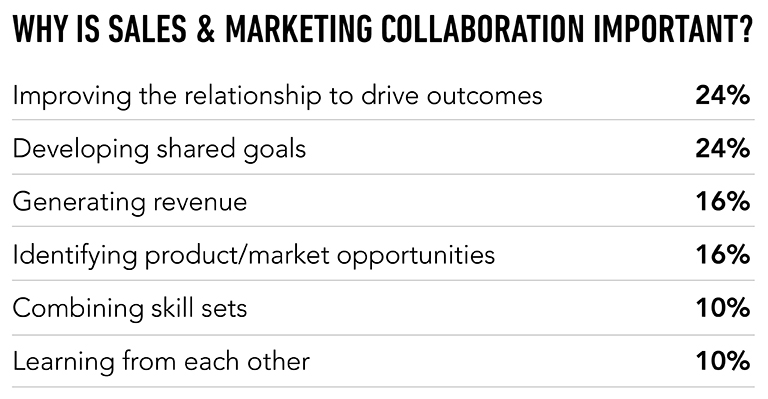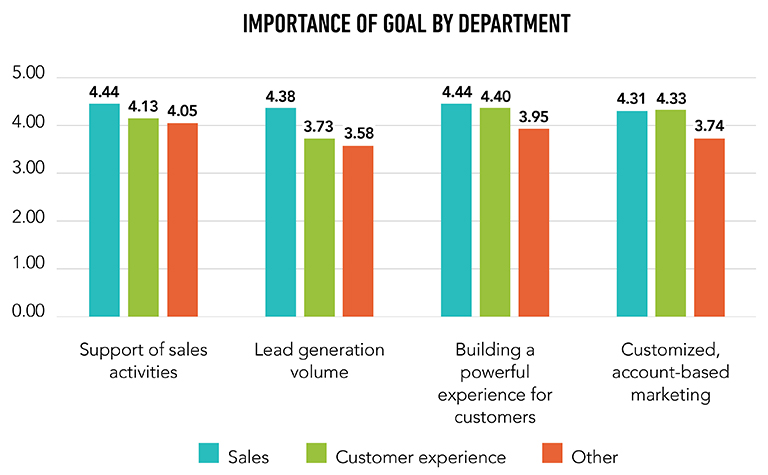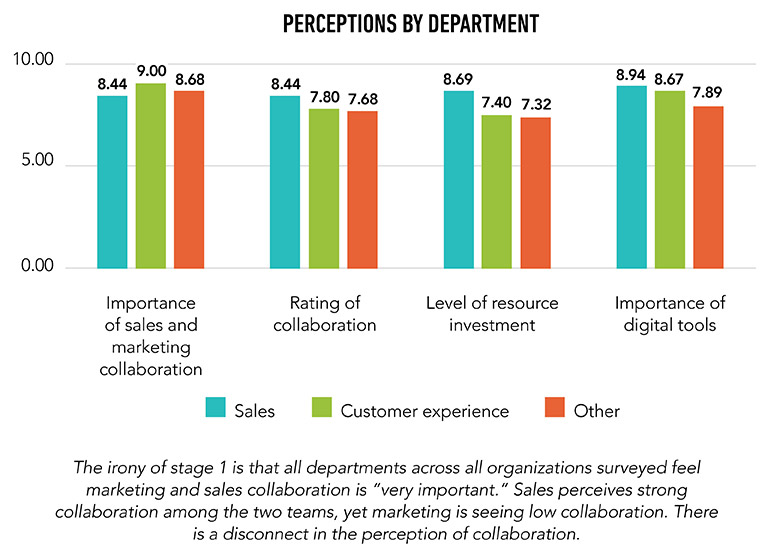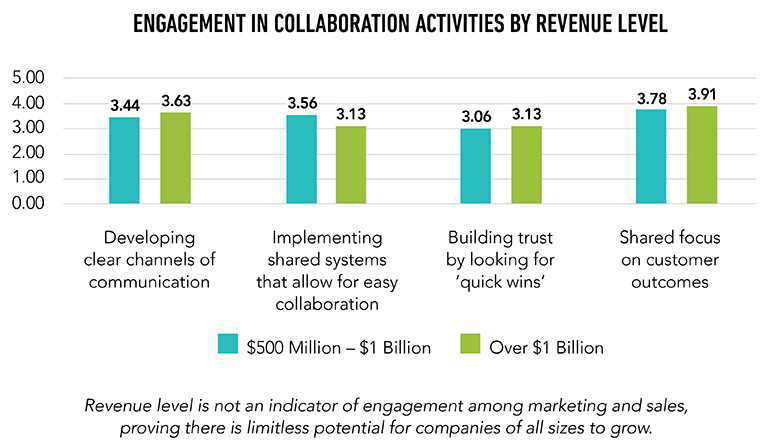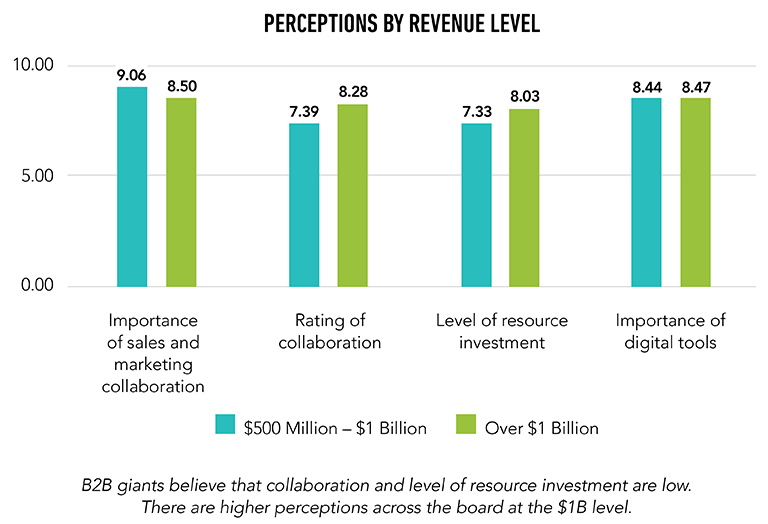How your teams can take off their gloves and take your organization to the next level
- Part 1: The dynamic that sparked our curiosity
- Part 2: Identify historical drivers
- Part 3: Companies must align sales and marketing for heightened success
- Part 4: These must-implement tools will fundamentally shift the way your marketing and sales teams operate
- Part 5: With customers in control, sales and marketing must combine forces
- Appendix
You’ve probably been there. It is time for another quarterly review: The prospect pipeline is slim, sales and marketing are rivaling, and the company missed its quarterly revenue target for the second time in a row. The head of sales and the head of marketing, both fiercely protective of their teams, instantly look across the table at each other.
SALES:
“Look, my team is making the calls, sending the emails, connecting with the decision-maker, but we need more and better leads. We need marketing materials that open more doors for us to go in and close those deals and we’re just not led to the right doors.”
Marketing:
“Yes, but our marketing plans are an attempt to widen reach. When you don’t knock on the doors we intend, it derails the more strategic initiatives. We can’t command the market if the team doesn’t have a unified approach around our company’s value proposition.”
Marketing:
“Now that we have finally invested in technology, we can expand your customer base to be stronger, broader and deeper. We only need all the information you’ve accumulated about our customers so we can make more educated guesses on our target audience—who, when, where and how.”
Sales:
“It has taken me years, my entire career, to zero in on who my customer is, and no one else is going to take them—I have experienced this from competitors and even other salespeople. I’m not uploading my customers’ information out into the abyss for anyone to find. Also, there are so many nuances to each of them, we can’t send them one flashy and broad message.”
Feel familiar? Both marketing and sales teams have had years to brew a contentious, or worse, siloed landscape. We got curious about this historically hard-hitting dynamic and why marketing and sales teams are fighting with each other rather than for each other. Could there be statistical evidence to prove if marketing and sales worked together, fully integrated, they would break down their silos, build stronger teams, and grow their business? We looked for answers, and we found them.
Part 1: We get curious
The coronavirus pandemic has served as gas on the flame of B2B marketing’s rapid digital evolution. Sales and marketing teams face the significant challenge of meeting customers on their terms in increasingly digital spaces. Yet a history of distinct silos means the two teams are often misaligned on how to do so.
But over the course of 18 months and more than 30 interviews with B2B marketing and sales leaders, we noticed a trend: The coronavirus pandemic seemed to have kindled a flame between the two teams.
So, to deliver the most impactful creative firepower to our clients, we sought to further understand why the disconnect between marketing and sales exists and how large organizations could bridge it.
We set out first to explore the current dynamic between sales and marketing teams in B2B organizations. More specifically, we focused on B2B giants: a company that reaches $500 million or more in annual revenue.
Could we find data and insights to support our theory that the pandemic shifted their relationship? And was the shift positive? We were curious if the pandemic shed additional light on the challenges between them, what their future partnership held and, finally, how technology could carry both teams through new challenges.
HOW WE TURNED CURIOSITY INTO ACTION
We partnered with third-party research company PATH to conduct quantitative and qualitative research to uncover the relationship between marketing and sales and see what we could learn when sales and marketing teams do (or don’t) align.
Five key phases conducted over an 18-month period included 78 total participants. All findings reported reached statistical significance.
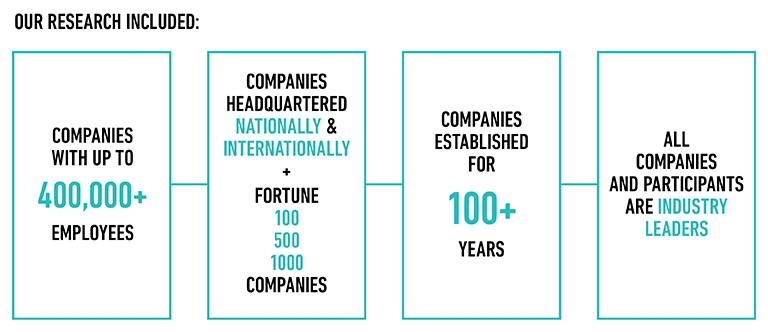
Phase 1: One-on-one interviews with marketing and sales leaders from B2B giants
Our phase 1 research developed over more than 18 months. Between conducting research for previous volumes of the Curiosity Report and candid conversations with our clients, we started hearing a trend: Sales had begun leaning into marketing initiatives at the onset of the 2020 pandemic. This shift started to expose an evolved dynamic between the two teams.
Phase 2: Secondary market analysis of marketing and sales
Phase 2 took a deep dive into existing research on the universal state of marketing and sales today. Through the examination of materials from trusted sources such as McKinsey & Company, Forbes, J.P. Morgan and others, PATH established a baseline for the relationship between marketing and sales and built historical context to illustrate why the two groups function as they do today.
Phase 3: Focus group analysis with 12 marketing executives from 12 B2B giants ($500M+ in annual revenue)
Phase 3 consisted of focus groups with marketing executives from industries including health care, manufacturing, pharmaceuticals, finance, insurance and consulting. Each participant was a manager, director, vice president or equivalent level.
Phase 4: Telephonic study analysis with 16 marketing and sales executives from 14 B2B giants
Phase 4 opened the research further to include analysis of marketing and sales executives from 14 additional companies spanning industries including health care, logistics, construction, information technology and more.
Phase 5: Comprehensive digital survey with 50 marketing and sales executives from 50 B2B giants
Phase 5 validated previous qualitative findings through a national quantitative study to validate the model and define key drivers of sales and marketing collaboration.
Participants were guaranteed anonymity in all research methodologies. Any information revealing the individual or their organization has been redacted.
- To what extent is the sales and marketing integration conversation taking place today?
- Does marketing have a seat at the table today? Does sales? What are those seats?
- What is the organizational perception of marketing and sales? How do they perceive each other? Why and how is that evolving?
- Is there a psychological gap between sales and marketing? If so, what is it, and how do we bridge it?
- What is the organization’s definition of integration—functionally driven, alignment driven or both? What is the outcome of successful integration?
- Will collaboration between sales and marketing produce a powerful customer experience? If so, how do you drive it?
Part 2: Getting to the root of the question
To understand the relationship between marketing and sales today, it is important to examine the origin of the two distinct functions.
Sales as we know it was formally defined in the late 1790s, partially in response to the Industrial Revolution. However, the practice has existed for as long as people have offered a good or service for profit. Sales has traditionally driven the creation of annual operating plans for companies and owns a place at the forefront of organizational thinking.
Most marketers spend 50% of their time supporting sales
Marketing was formalized nearly a century later when it was defined as an applied branch of economics. It wouldn’t be recognized as its own discipline until the 1900s and has since existed mostly as a support function for sales. Even today, most marketers spend 50% of their time directly supporting sales.
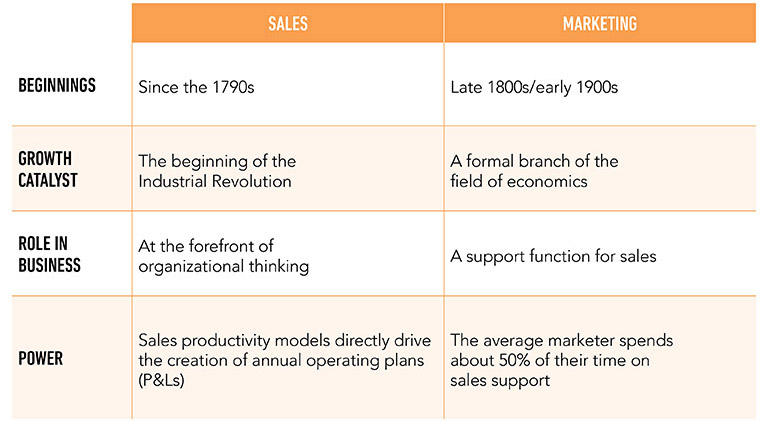
Because sales goals inform the business plan, sales metrics are often more aligned with bottom-line impact, whereas marketing’s ROI is often viewed as difficult to prove.
Years of being treated as two wholly separate entities in most organizations has led to frustration and friction between sales and marketing departments and created barriers to collaboration. It comes down to perspective.
Sales often believes that marketing sets prices too high, making it difficult to sell, and that marketing takes a larger share of the budget that could be used for hiring more salespeople. On the other hand, marketing believes that sales rarely executes on its carefully laid plans and is too hyper-focused on individual prospects to have awareness of the greater market.
While marketing believes its purpose is to create a customer, with a focus on customer acquisition and retention, sales has been responsible for deep engagement with the customer and closing the deal. As marketing has increased in prominence in recent years, it has led to sales teams unraveling their protective nature over their targets. Sales has historically been opposed to segmenting, targeting or even revealing customer information to marketing.
If this dynamic sounds familiar, you’re not alone. Our research suggests that a similar feeling exists across the country in many types of organizations. The way sales and marketing teams are staffed deepens the ideological divide. Marketing teams apply their skills in data and emerging technology, whereas sales teams focus on people skills and relationship building.
Identifying and leveraging the unique strengths of sales and marketing teams will lead to more powerful outcomes.
To understand both the obstacles and the opportunities facing B2B organizations, we referenced our focus groups and developed two personas encompassing the drivers and personalities of sales and marketing.
Sales: Entrepreneurial
Relationship driven: “It’s in their nature. They’re colloquial, type A, all of those things that are relationship driven.”
Makes it happen: “If you are truly an entrepreneur, you’re willing to take risk and have the ability to make things happen.”
Likes to win or make money: “When you have a good sales org and culture, you have people who are willing to bet on themselves and willing to put their financial success at risk and have the capabilities to achieve success.”
Independent: “They are independent and want to be able to develop a process that works for them. They have their own rhythm.“
Marketing: Visionary and optimized
Market landscape defining: “Helps set the vision where we are going, why we exist and how we reach ideal customers. Visionary—big-picture-thinking dreamers looking out to the future to bring concepts to others.”
Product creators: “Visionary—absolutely—especially market positioning. Taking the goods and services we provide and understanding: Where do we stand relative to the marketplace, with product, with where the market is headed?”
Data driven: “Optimized is more of a last 10–15 years kind of thing. It didn’t used to be as detailed. We’re in a new age, with digital, data and empowered consumers. You have to be data driven to meet the increased consumer demands.”
Focused on prioritization: “Here are the cards we’re dealt, team. I know it’s not everything we want—we haven’t given leadership the justification. We take what we get. Incredible opportunity for us to prove ourselves. Be proud and happy when you optimize. Celebrate the pack.”
80% of respondents agree that salespeople are very entrepreneurial. Respondents were mostly aligned around marketing having a “visionary” culture.
Sales and marketing have lived in their own separate lanes until recently. However, the events of 2020–2021, combined with a changing marketing landscape, shook things up significantly. The market is evolving quickly, and so is the customer.
There are three key drivers of effective and powerful sales and marketing alignment at large organizations:
- 1. First, build trust by proving value at every interaction
- 2. Second, drive consistency with systems and deliver value across the organization
- 3. Finally, focus on the customer to integrate and provide a valuable and seamless experience
Part 3: What we learned
The pandemic rapidly accelerated the rising integration of technology into business and purchasing. Virtually overnight, business had to be done almost entirely online. Traditional processes and tactics were completely disrupted, forcing roles to continually evolve to meet the complex needs of customers. Companies put marketing front and center in 2020 as they scrambled to reinforce brand relevance and authenticity to weather the storm.
As we found and noted in previous Curiosity Report volumes, the overall situation compounded a growing fear that salespeople were becoming obsolete.3 Planes were grounded, tradeshows were canceled, sales calls were called off and budgets had to be shifted to more digital areas that left the sales team having to rely on marketing more and more. And the number of digital touchpoints customers require has increased, leading to a greater need for communication and a reliance on digital channels that sales has not historically utilized. Conversely, marketing experienced validation in leveraging of its technology- and data-driven methodologies. In order to meet the customer where they are, sales, a customer knowledge powerhouse, had to rely more on marketing, a consumer trend bloodhound. And the customer had shifted online.
“Sales really took notice of marketing over the last year. They were living on the road with their customers. The last year has forced them to notice what we’re doing. Now we’re doing it together.”
Suddenly, the power dynamic had changed, but maybe not in the way we expected.4,5 We asked, “Who owns the customer now? Is it marketing, who has the digital reach? Or sales, who still has the most intimate understanding of the customer?”
None of the above.
The number of digital touchpoints customers require has increased, leading to a greater need for communication and a reliance on digital channels that sales has not historically utilized.
Ultimately, the customer belongs to the customer.
Businesses weren’t the only ones who had to shift online. Customers and buyers were already migrating in droves to digital, and the impact of the pandemic accelerated e-commerce penetration by the equivalent of roughly 10 years within just a few months.6 Both B2B sellers and customers are enjoying the speed of remote interactions—and have realized they prefer less interaction with traditional sales methods.
E-commerce continues to rise (even in the B2B world), and the pandemic accelerated this shift: Consumers spent $211.5 billion online during Q2 2020, an increase of 31.8% from Q1.7 The demand for no-touch product and service delivery, another result of the pandemic, shows no signs of slowing down. The customer’s buying journey has shifted online in big numbers. In our previous Curiosity Report, Vol. 3, we learned 97% of buyers feel comfortable making five- to six-figure purchases directly online without sales support. With the rise of customer autonomy comes the expectation of customization.
Customers are spending their time in digital spaces and have more control than ever before over how and when organizations reach them. They crave personalized information and support, as opposed to generalized content. And they experience your business cross-functionally. They don’t differentiate between who sales and marketing are. Rather, they want access to the information they need to make a decision. To that end, neither sales nor marketing can fulfill all the customers’ needs on its own; everyone must work together toward the same long-term goals.
As customers force the shift from analog sales to hyper-automated, digital-first engagements, companies are responding by moving from a seller-centric to a more buyer- or customer-centric ideology that is right in marketing’s wheelhouse.
The findings from our secondary analysis revealed a growing trend toward digital interactions and customer autonomy:8
- 92% of buyers start with an information search online
- 60% of buyers prefer not to interact with a sales rep as the primary source of information
- 53% believe that doing independent research online is better than interacting with a salesperson
- 90% won’t accept a cold call
- 62% say they can now develop selection criteria or finalize a vendor list based solely on digital content
- 75% depend on social networks to learn about organizations
Sales and marketing must combine forces to effectively serve the modern customer.
Research revealed that even if marketing and sales teams want to trust each other and work together, actually doing it can be a tall order. Collaboration and integrating the two teams takes time—merging communication and meetings, aligning on which customers to target, navigating competing priorities, moving away from traditional methods and trialing out innovative ones, and then some. It’s not easy when the two teams are already moving at lightning speed in their day-to-day roles.
To that end, here are three key lessons in driving marketing and sales toward integration.
1. MARKETING SHOULD POSITION SALES AS ITS INTERNAL CUSTOMER
Sales and marketing work together best when marketing positions sales as an internal customer. In fact, more than half of the participants in Phase 3 of our research identified this as a best practice. Positioning sales as an internal customer builds trust and buy-in. The ultimate goal is to evolve the fraught relationship into a productive partnership.
Fortunately, marketing teams’ skills are perfectly suited for building a powerful communication plan to facilitate the partnership, including establishing regular check-ins and procedures to optimize collaboration. The teams should leverage each other’s strengths and share knowledge around processes that have yielded success. And the two teams must celebrate wins and tackle challenges together.
Sales:
“You give a salesperson a hot lead and they will love you for life.”
Marketing:
“[Show] constant reminders of our value. It takes constant reinforcement, showing our value to the organization.”
B2B organizations will see greater success if sales and marketing align their goals and key performance indicators (KPIs), which then ladder up to operational KPIs. Functional integration can have a significant impact on organizational success:9, 10, 11, 12, 13
- 32% higher revenue
- 36% more customer retention
- 38% higher win rates
- 108% better lead acceptance
- 67% greater probability that marketing-generated leads will close
- 208% greater contribution to revenue from marketing-generated leads
2. ALIGNMENT MUST OCCUR IN ORDER TO REACH INTEGRATION
Integration happens in phases. Mark these milestones as you work toward full integration:14
Undefined
Sales and marketing have grown independently of each other and are largely preoccupied with their own tasks and agendas.
Defined
Sales and marketing set up processes to prevent disputes and conflict. Tasks are delegated appropriately, and each team sticks to its own agenda.
Aligned
Clear boundaries still exist between sales and marketing, but they are flexible. Departments engage in joint planning and training.
Integrated
Boundaries between sales and marketing are blurred and both departments commit to redesigning the relationship to share structures, systems, rewards, wins, etc.
Sales:
“Collaboration is the engine for any organization to generate revenue. Without it, you don’t have a business.”
Marketing:
“You have to be aligned so that we all broadcast the same message. Marketing is casting the net for the prospects, and sales nails down and catches the fish. You have to go hand in hand with all of the strategies—for all aspects of the business.”
Aligning on KPIs will help marketing and sales navigate the conversation toward integration. Data can also prove the value of marketing efforts and demonstrate how technology positions a unified marketing and sales team to grow revenue together. Use data to increase customer behavior visibility.
Marketing teams should use data as a driving force in how they position themselves to sales.
Integration ladders up to a two-fold mission with both the customer and the organization in mind. Customers are leading the charge and demanding that sales and marketing customize the message for them so they can receive maximum value at every touchpoint. But the organization also needs innovation, which requires marketing and sales to leverage their unique skills in tandem—marketing to think from the outside-in, and sales to deliver deep customer knowledge and insight.
Sharing:
“Sharing and collaborating—sales cannot hold back things from marketing because they’re being territorial—and vice versa with marketing. You have to be willing to give and listen.”
Communication:
“Communication—having conversations with each other; like peas and carrots, both can help one another by having consistent lines of communication, thinking through execution and outcomes; sharing in the plan and owning outcomes mutually as well.”
Sales and marketing bring different yet complementary skills to the table, but both groups need to recognize what the other has to offer and amplify those strengths.
Sales should use its entrepreneurial spirit to drive meaningful action, and marketing should embrace its visionary nature to develop innovative strategy. When both are allowed to shine, they can build trust and exchange value in every interaction instead of competing.
A key to collaboration is to have the same objectives, which is challenging when sales and marketing can have a different responsibility on any given day. However, if teams have a leader supporting both marketing and sales objectives, it will ultimately be easier to collaborate, and therefore lead to integration.
Consistency is key. When opening channels of communication between departments and building procedures for collaboration, both groups should ask themselves if their systems are creating value across the organization. To ensure value, focus on the customer as your North Star and build around the necessity of providing the customer with a seamless experience.
Sales:
“Marketing tends to build strategies, then sales validates. Collaboration is more difficult because they’re working more independently. You have to have processes in place to make sure collaboration happens.”
Marketing:
“It is invaluable. We have long sales cycles. Better integration and alignment could help close those faster.”
“When there’s marketing and sales alignment, there is a greater outcome…around 5% greater. We have a very good win rate when we are on deals. I just kicked off this program in January and we are already five deals in at triple digit millions [that] we helped bring in for sales. It has really made us successful. The fact that sales is coming to marketing for strategy versus just coming to say, ‘Make this pretty’ is huge.”
Focus on the customer as your North Star and build around the necessity of providing the customer with a seamless experience.
3. LEVERAGE TECHNOLOGY TO KEEP PACE WITH THE DIGITAL WORLD AND SUCCESSFULLY SCALE INTEGRATION
If B2B organizations want to grow, then going back to old, siloed roles is not an option. Customer habits are evolving in today’s mercurial digital landscape, but marketing has grown its initiatives in and around digital so they are made to persevere and scale. And it goes way beyond customer relationship management. Digital should be a primary tactic for reaching B2B customers, not just an add-on to the strategy.
Historically, marketing has been an advocate for employing technology while sales has preferred to grow relationships with in-person connections. The pandemic all but required everyone to adapt to new technology, underscoring marketing’s value to many organizations as technology kept customer insights coming despite in-person shutdowns.
That trend isn’t going anywhere. The prolonged pandemic continues to drive customers toward digital spaces.15 Meeting those customers where they are requires a technology lift to keep gleaning insights and serving the right messages.
Customers are unleashed and autonomous. As they research digital content and social networks independently, they are looking for digital-first engagements from brands and organizations.
Sales:
“The importance of marketing and sales collaboration is at the top of the scale—a 10 in importance. The pandemic has illustrated it—the buyer’s journey has changed so much over the past 10 years. Phone calls don’t work, people aren’t opening emails, you’re not allowed to show up at their office. Traditional ways don’t work anymore. You have to be where they are looking and know what they’re looking for—and that takes integration from start to finish.”
Marketing:
“Customers expect that we are in sync with each other. Research tells you everything is customer-centric—there’s really no room for error. They’re looking for a united front—for them to feel special. And for us to show that we understand them—we’ve taken the time to learn about them as a person or as an organization.”
Leadership:
“Customers don’t care where marketing and sales begin and end; they want one seamless experience.”
Part 4: What’s next
A new capability model can help B2B organizations identify where their sales and marketing teams land on the spectrum.
Sales and marketing both hold vital roles in a B2B organization and in the customer’s journey. By defining and celebrating those roles, your sales and marketing teams can forge ahead with renewed purpose and begin paving the way for true integration.
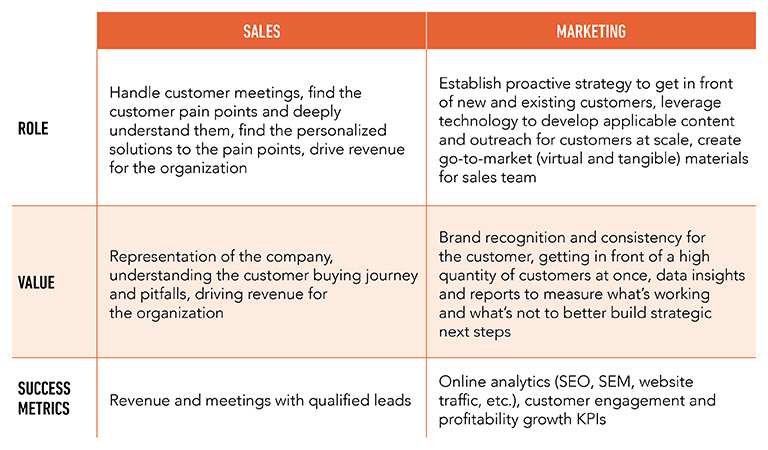
PATH/treetree Sales & Marketing Collaboration Model— The Road to Customer Experience
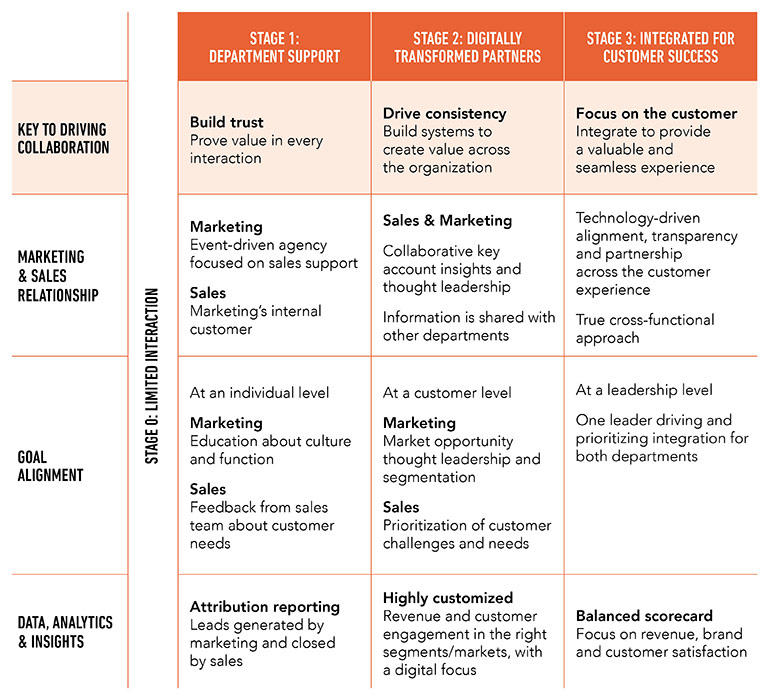
It’s important to understand where your organization lies on the Sales and Marketing Collaboration Capability Maturity Model. To start, consider asking your marketing and sales teams the following questions:
- 1. What data are we utilizing to understand what content is driving sales leads?
- 2. How are our digital and social media teams measuring KPIs?
- 3. Are marketing and sales measuring the same KPIs?
- 4. Is marketing successfully pulling insights and then marrying these with anecdotes from sales?
- 5. How much time do we spend generating content that serves our audience versus content that sells?
- 6. Do our marketing and sales teams have regular communication check-ins?
The answers to those questions will help define your sales and marketing integration maturity stage, which will then help you drive action to further integrate.
Across all 5 phases of the sales and marketing collaboration study, 82% of all respondents agree that sales and marketing collaboration is “very important”
STAGE 1: DEPARTMENT SUPPORT
At the Department Support level, only 43% of respondents felt that collaboration was occurring, and 100% of that sample agreed a lack of trust was one of the main challenges they faced. Shifting marketing’s positioning to viewing sales as an internal client is a crucial first step to bridging the gap.
Key to collaboration:
Build trust by proving value in every interaction
As initial conversations begin around integration, start by celebrating wins together. Marketing should assume an educator role, expanding the sales team’s knowledge about digital channels and tactics, and showing how marketing can leverage them in support of the sales team’s mission and KPIs. Sales should share their valuable customer insights and advise marketing on customer needs. The two teams need to recognize and celebrate each other’s strengths as marketing generates leads and sales closes deals.
43% of respondents felt that sales and marketing collaboration was occurring at the Department Support level
STAGE 2: DIGITALLY TRANSFORMED PARTNERSHIP
At the Digitally Transformed Partnership level, 71% of respondents felt that although collaboration was occurring, it was inconsistent. However, all of them agreed that they were already seeing collaboration drive value for the organization. At this level, the key to success is aligning marketing and sales to prioritize the customers’ needs above territorial squabbles. Expect teams to experience experimentation and innovation when creating customized systems and data panels.
Key to collaboration:
Drive consistency with systems that create and deliver value across the organization
Deepen the relationship by narrowing in on the goal of creating the most effective digital experience for the customer, in turn bringing in greater revenue. At this stage, marketing should bring segmentation data to the table, and sales should choose which customer needs to prioritize to inform the overall strategy. At this stage, the lead generation and follow-up processes should become second nature enough that the conversation between the teams will shift to be about customer engagement.
71% of respondents felt that sales and marketing collaboration was occurring at the Digitally Transformed Partnership level, but was inconsistent
STAGE 3: INTEGRATED FOR CUSTOMER SUCCESS
At the Integrated for Customer Success level, content becomes limitless and the customer experience is the principal focus.
At this level, 85% of respondents reported feeling as though their sales and marketing collaboration was comprehensive across the whole customer experience. To maintain strong levels of collaboration and growth between sales and marketing, invest in change management and appoint one leader who will commit to prioritizing further integration.
Key to collaboration:
Focus on the customer to integrate and provide a valuable and seamless experience
Mature integration means that the customer comes first in every decision. Conversations aren’t about the responsibilities of marketing and sales anymore; they’re about how the team, singular, can better serve the customer the information it needs to choose your product or service. Metrics should be shared transparently and used to fully deliver on customer expectations.
85% of respondents felt that sales and marketing collaboration was comprehensive across the customer experience at the Customer Success level
Part 5: Summary
Identifying and leveraging the unique strengths of sales and marketing teams will lead to more powerful outcomes.
Ultimately, the customer belongs to the customer.
Sales and marketing must combine forces to effectively serve the modern customer.
A new capability model can help B2B organizations identify where their sales and marketing teams land on the spectrum.
The digital advent is here, and it has given customers unprecedented control over how and where they interact with brands. B2B organizations must respond by integrating their sales and marketing teams to provide a seamless, personalized experience to each individual customer. By leveraging the sales team’s intimate knowledge of the customer and can-do attitude with the marketing team’s visionary strategy and creative talent, brands can serve a customized experience at each touchpoint, yielding higher quality leads and greater brand strength for the organization.
